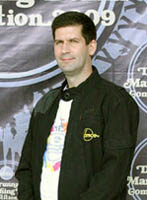Judging : Article Andy Dougharty for DMC 2010

Mr. Andy Dougharty*
If I could give just one piece of advice to competing bands it would be this : read and understand the criteria……………….!!!!
You need to understand the criteria based judging system that is being used by just about every competition in the world. It tells you EXACTLY what you need to know to get the highest possible scores in every caption. I am always
amazed (and frustrated) when people start to complain about the scores, but have no idea at all how and why we gave them the scores we did. Here is a very simple demonstration of the process :
Criteria
|
Box 1
0 – 25 |
Box 2
26 – 50 |
Box 3
51 – 75 |
Box 4
76 – 100 |
|
Uses only percussion instruments
|
Uses woodwind and percussion instruments
|
Uses brass and percussion instruments
|
Uses brass, percussion and woodwind instruments
|
If this is the criteria the judges must use, then they are obligated to follow the criteria. Notice there is nothing in the criteria about quality. That might be in a different box or caption. If I was a judge and the best band I had ever seen in my life had just performed, but they only used brass and percussion instruments, then the highest score I could give would be a 75. My hands are tied! Even if I want to give them a higher score, I cannot – because the criteria determines the box in which they are scored. If they had used just one woodwind – maybe a flute in the pit for some special effect – then I would have been able to give them a score of 100.
Criteria based assessment is an excellent system when used by judges who understand how to use it correctly. It is an excellent tool for instructors who read it and pay attention to the details. Judges are human and we do our very best,
but we can be affected by different things. The criteria system helps keep us honest and precise in our evaluations. The old “sliding scale” system was inconsistent and left too much room for scores based on issues not related to the caption.
Often, in the highest scoring boxes, you will see statements like “All members of the ensemble….” That means ALL MEMBERS. If I see just one member who is not doing what the caption is focussing on, then I cannot give the band any score in the range of the highest box. Your kids NEED TO KNOW this.
Mati siji, mati kabe! Sometimes criteria describes “a wide range of emotion.” What is that? Making me feel good for the entire show is nice, but it is does not display a wide range of emotion. How many emotions can you describe? Wikipedia has a list that is so long that I can’t paste in here without adding several pages.
I once judged a Winterguard competition where I was given a list of criteria that included the music used in the performance. Part of the score went towards things related to music, including repertoire, continuity, suitability and quality (including mixing and editing) of sound. It was obvious right from the start that many groups had not read the criteria and had assumed that the scores would be based on just the performance and execution of technique. WRONG! I had no other choice but to follow the criteria. As a result, some groups received a score much higher or lower than they expected. The group I liked the most put on an awesome performance. They were outstanding on so many levels… until their last song. The recording sounded like someone had held their handphone close to the television to make the recording and it was such an extreme change in style of music, that it was a shock. There was no sense of continuity. My score dropped down an entire box because the criteria demanded it.
So, read the criteria carefully and make sure that you and every member of the staff and performing group know and understand what is required. If you disagree with a judge’s score and you really understand the criteria, you will be able to make a much better and more intelligent argument.
*Ketua Dewan Juri DMC 2010
Related posts:
Short URL: https://trendmarching.or.id/read/?p=1323



